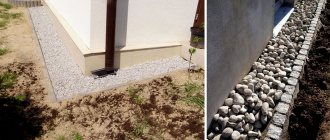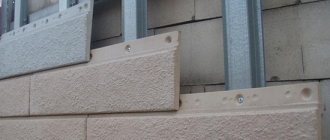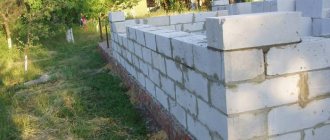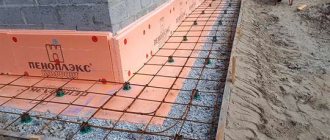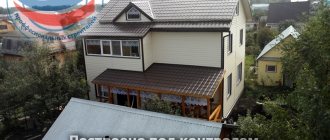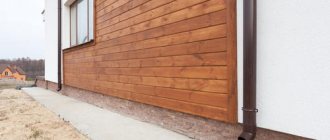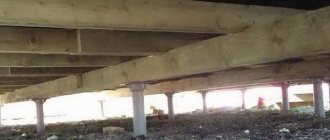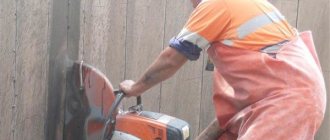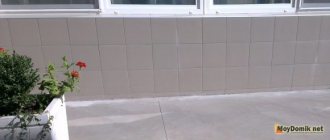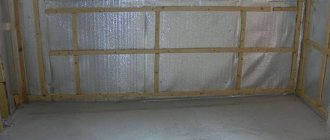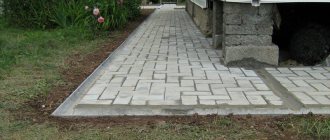Anyone planning construction should understand that the grade of concrete depends on the conditions under which it will be used. The selected blind area should be economical and have good strength properties. In addition, the process of using it for repair and construction work should not cause you any difficulties.
Read the instructions for pouring the blind area.
Concrete blind area around the house” width=”402″ height=”295″ />
The blind area is a waterproof strip that extends around the entire building. It helps drain rainwater away from the foundation.
In order to make it from concrete, you should adhere to the following rules:
- The top layer of the blind area should be several centimeters larger than the horizontal waterproofing.
- The outer edge should be 30-50 cm longer than the overhang of the cornice.
- It should have a slight slope from the walls of the building.
Despite the fact that the concrete finishing around the perimeter of the building is a simple mixture, its operating conditions are somewhat more difficult compared to other building materials.
Depending on the season, the blind area may be subject to the following influences:
- precipitation;
- temperature changes;
That is why it is important to choose concrete that has high frost resistance and good water resistance. When buying pre-mixed concrete, you don’t have to mix it in a mixer, since this material is based on high-quality cement and crushed stone.
It also contains plasticizers and water. However, if you were counting on a small amount and cannot purchase high-quality concrete, you can prepare it yourself.
Cement grades and requirements
Concrete grades and their ratio of parts” width=”552″ height=”298″ />
Concrete grade M200 and cement grade M 400 are the best solution for finishing any home. By choosing this brand, you will be able to create a strong fence that will strengthen the foundation and preserve the house.
For maximum protection of the building, only the highest quality materials are used. In order to make the blind area not only beautiful, but also of high quality, you need to choose the right brand of cement, as well as the proportion of ingredients in the solution.
The thing is that weather changes and temperature changes do not have a very good effect on any structure. And if you choose weak concrete, it will not be able to protect the house from a possible collapse.
It is worth giving preference to frost-resistant material , which will not crack even on the coldest winter day. Concrete grade M200 and higher, excellent for blind areas. Cement should be used grade M 400 - it will ensure the reliability and durability of the structure.
The concrete blind area must necessarily comply with general standards and norms. Slope, correct design and many other important points - these are not all the important components that can be regulated by regulatory documents.
If you have difficulty creating a good blind area, you can change the grade of concrete. To do this, you need to prepare a mixture that will contain a greater or lesser percentage of cement or sand.
You can change the grade of concrete before it is laid. If you poured the mixture and realized that you chose the wrong brand, do not be upset, because you can use reinforcement to give the structure strength.
The concrete blind area must comply with certain rules and requirements, namely:
- It must be adjacent to the building along the entire perimeter.
- The slope should be no more than 10%.
- The outer edge must be free of curvature.
- The quality of concrete must be at the level and meet generally accepted standards.
- The bottom layer is compacted soil.
- There should be compacted soil at the junction of the walls of the house
A high-quality blind area must not only comply with SNiP, but also have a thickness of at least 15 cm. If it is used as a parking lot or pedestrian area, it must be very durable. A slope that is too steep can destroy the edges of the house, so it is very important to follow the general rules and recommendations.
Building codes and regulations (SNiP) are generally accepted information on standards for renovation work. Concrete finishing, like all other construction projects, must meet standards.
By adhering to building codes, you can preserve the foundation of your home and make the structure itself reliable. Thus, you will not be afraid of heavy rain and other precipitation.
The nuances of mixing the solution for the blind area
What concrete should be like for a blind area after mixing the solution is a common question when constructing a structure. Excess water means low strength indicators of the finished composition.
When making the mixture with your own hands, the water must be completely absorbed into the cement. You need a solution with the consistency of thick sour cream.
If the liquid is not sufficiently absorbed into the cement, then some of the water remains in its pure form. In the future, the concrete will quickly collapse.
Concrete is poured into the formwork and leveled with a trowel or spatula.
For the blind area of the house, a fraction of crushed stone from 5 to 20 mm, made from river gravel or rock, is used. Small aggregate – high quality of adhesion and strength of concrete. The size of the crushed stone affects the proportion of water: the finer the gravel, the more liquid is added.
The sand is screened to remove lime, clay and silt before being added to the cement.
Calculation of solution for pouring
The blind area is a narrow concrete slab. To fill it with your own hands, you need to calculate the amount of ready-made solution.
- The area of the structure is calculated: the width of the rectangle is multiplied by the length. The result is multiplied by the height of the blind area.
- To the resulting number, 15% of the mixture is added for reserve.
The blind area is 20 m2, height - 15 cm. Calculation: 20 * 0.15 = 3 m3 of mixture. Plus a reserve percentage. As a result, 3.5 cubic meters of solution are required for a structure of 20 m2.
Mixture composition and pouring features
The mass ratio of materials should be as follows:
- 1 part cement;
- 2.8 parts sand;
- 4.8 parts of crushed stone;
All this must be mixed thoroughly to achieve a uniform consistency. It is very convenient to work with such a mixture.
Concrete for finishing must be durable and frost-resistant, as well as waterproof - only such a structure can have a long service life. Material with strength class B15 is most often used for such purposes.
The proportions of all components must be carefully observed. The composition of the blind area is not complicated - it is only important to maintain proportions and use high-quality materials.
The thickness of the concrete tape should be at least 7-10 cm. If you use reinforcement, the mesh should overlap the concrete tape and be 5 cm longer. If the rules are not followed, the metal may succumb to corrosion. The slope of the tape when laying concrete should be 1.5-3 degrees - this way you can hide all the seams in the corners of the building.
How to make concrete yourself
So, the grade of concrete for the blind area is M200 or M250. How can you do this yourself?
You will need a concrete mixer. If you calculate the required amount of solution, you get an impressive figure. For example, for a house 6x6 meters, we determine the volume of concrete for a blind area 15 cm thick:
Add a slope, we get about 6 m 3 of solution. It is impossible to mix such a volume well by hand. By the way, you can rent a concrete mixer.
The composition of concrete for the blind area is classic:
- Portland cement M400 or M500;
- Water;
- Sand;
- Crushed stone fraction 5-20 mm;
- Plasticizers (recommended).
Proportions of components for concrete on the blind area:
| M400 | 1 : 2,8 : 4,8 | 54 | |
| M500 | 1 : 3,5 : 5,6 | 62 | |
| M250 | M400 | 1 : 2,1 : 3,9 | 43 |
| M500 | 1 :2,6 : 4,5 | 50 |
The average cement consumption per 1 cubic meter of solution is about 240-270 kg.
For convenience, you can calculate the volume in buckets of 10, 12, 20 liters. If we take one bucket as one, then we take the remaining components proportionally.
The amount of water is taken as half the volume of cement, but this indicator can vary - it is necessary to achieve a plastic and workable consistency so that the solution can be laid at an angle and does not flow down.
Application area
The design of the finish, namely its underlying layers, depends on geological conditions. It is necessary to take into account how the drainage is organized. It has many areas of application.
A simple blind area is used for dachas, estates and houses in the village. In order to strengthen the building in this way, a layer of crumpled clay is used, and then a hard covering is placed on it. Clay is an excellent waterproofing agent and provides good water drainage.
The cheapest coating is a layer of crushed stone.
Concrete blind area is a more expensive and durable option. It will allow you to control the level of precipitation and protect any structure from deformation.
Brand of concrete for blind area
The blind area does not carry structural loads, so it can be made from low grades of concrete. This reduces the cash costs of building a house.
Low brands include M100 and M150. It is from them that the blind area around the house is often cast. In addition, the M200 brand is used for the construction of street paths and blind areas. It has higher characteristics of strength, water resistance, frost resistance and a higher price.
Blind area of the house: reinforcement of the screed increases strength
Table: comparison of characteristics of concrete grades for street blind areas and garden paths
Advantages and disadvantages
Concrete blind area
Hard finishes are very strong and durable, however, they also have their drawbacks. These include the negative effects of water. When water gets on it and lingers on the surface, it can lead to partial destruction of the foundation or the entry of dust and dirt into the house.
Soft blind areas are often used in construction, as they have many advantages over hard ones:
- Not afraid of any ground shifts that could cause water to freeze.
- There are no cracks in the blind area through which moisture can enter the foundation.
- It does not need constant repairs , so you can save not only your effort, but also the money spent on repairs.
- The technology for laying soft finishes is lightweight.
- If you use penoplex as insulation, the soil will not freeze, which means the house will last even longer.
The soft blind area has only one drawback - constant maintenance. Weeds that will grow through the finishing must be promptly removed, and the lawn grass must also be trimmed.
Why do you need a blind area?
Blind area around the house
A blind area is a path around a private house that does not allow melt or rain water to reach the foundation walls underground. The construction of a blind area protects the foundation from getting wet, and the walls from dampness (walls get wet when capillary moisture rises from a wet base). If the foundation is dry, then its durability is greater, and the reliability of the structure is higher. When the soil freezes in winter, the wet foundation of a house also freezes and collapses.
That is why the quality of the blind area determines the service life of the building. Periodic freezing of the upper part of the foundation forms cracks in the base and walls, and therefore destroys the structure. What should a high-quality blind area around the house be like?
- The blind area must have sufficient dimensions (thickness of the screed and width of the path).
- The blind area is cast from a mixture that is intended for year-round outdoor use.
Correct construction of the blind area
Main components
The quality of the finished concrete depends not only on strict adherence to proportions, it is also related to the quality of the mixed substances and their modification. To make concrete durable, you should follow the basic recommendations.
Cement
Without this component it will not be possible to prepare concrete at all.
Cement affects the strength of the finished product and the speed of its hardening.
Among all the variety of choices on the market, you should choose Portland cement. It will allow you to get the best adhesion of all components.
The main characteristic for choosing cement is the brand. It allows you to determine the type of work for which the manufacturer recommends use. The brand is designated by the letter “M” and is measured in kilograms per cubic centimeter. The strength of the dry mixture depends on it.
In order not to make a mistake in choosing cement based on quality and cost, you should determine in advance the type of work that you plan to perform:
- Masonry. To create a load-bearing wall, cement M400 - M500 is best suited. Other types of structures can be made from a mixture of M300. If you need to create a small structure (a gazebo or a shed), then M200 cement is enough.
- Foundation. If it is necessary to lay the foundation for one-story buildings of modest size (garage or summer kitchen), it is allowed to use M200 cement. If the building should be residential and have several floors, then it is better to choose M400 or M500 binder.
- Blind area. To create a blind area, cement M50 or M150 is suitable. If it is necessary to repair a certain surface, then you can not pay attention to strength at all. But pouring the floors is a different story. Here you should select a specific brand of cement. It depends on the performance characteristics of the floor.
- Plaster. When preparing a mortar for plaster, you should choose a binder with a strength of M300 or M400.
Important! There is no point in buying a lot of cement in reserve at once, because after a month its strength begins to decrease. After two months, 10% is taken away from it, after 6 - 50%, and after a year the material becomes unsuitable for use.
If during the preparation of concrete you have to mix several brands of cement, then the proportions of all components will have to be changed. This is done due to the fact that the content of high-grade cement in the finished solution should be less than that of low-grade cement.
Crushed stone
This ingredient provides the finished composition with high compressive strength.
To prepare a high-quality concrete mixture, it is necessary to select crushed stone with a size of 1-2 cm.
If larger stones are present, it is better to use them for factory work.
You also need to monitor the presence of clay inclusions and the cleanliness of the crushed stone.
Sand
This component is simply necessary for preparing concrete. The best solution would be to take river or quartz sand (it contains shiny crystalline inclusions), the particle size of which is 1.2-3.5 mm.
You should also pay attention to the presence of lumps of clay in the substance. If it is present, then the raw material is second-rate and it is not recommended to use it for preparing concrete. Clay can significantly reduce the strength of the finished solution. In some situations, crushed gravel may be used instead of sand.
Important! Before starting work, it is recommended to sift the sand through a sieve to completely remove any foreign matter.
If the composition is being prepared for small-scale construction, then the type of water is not important; any water can be used.
